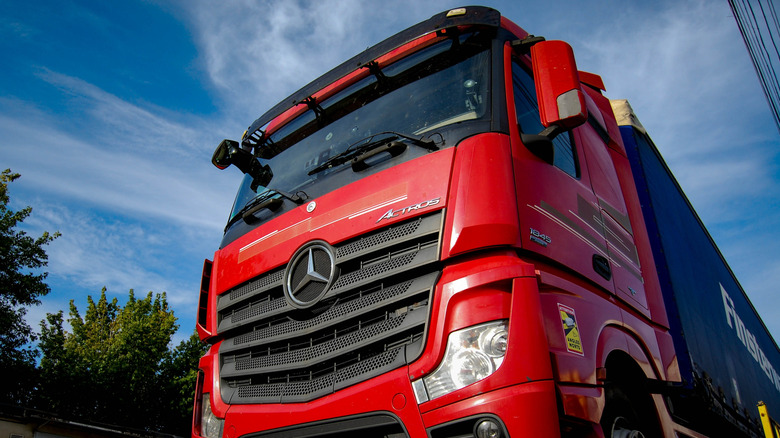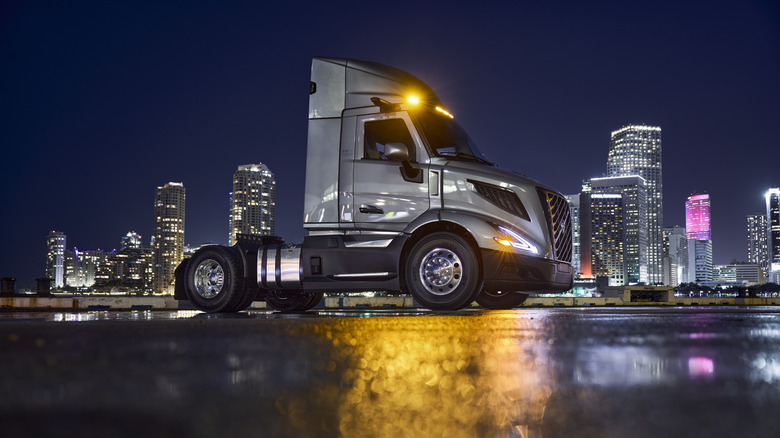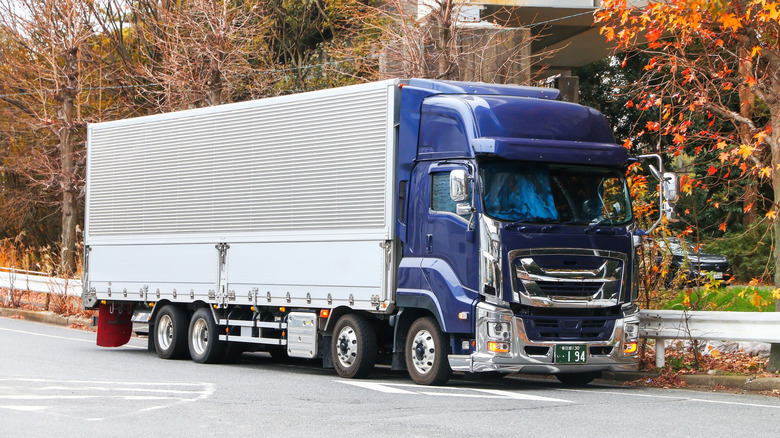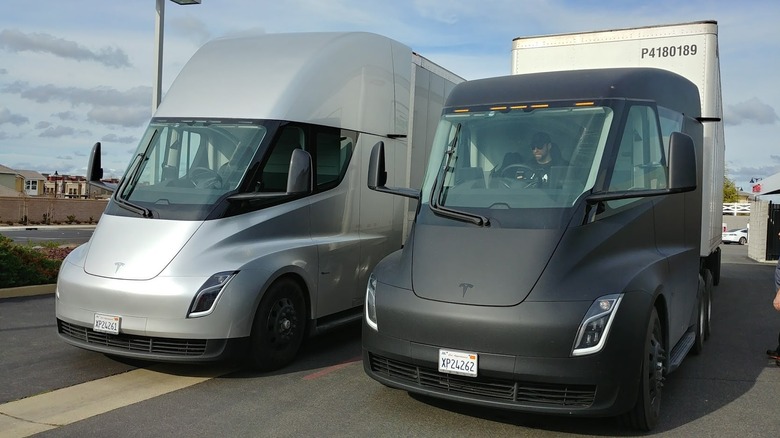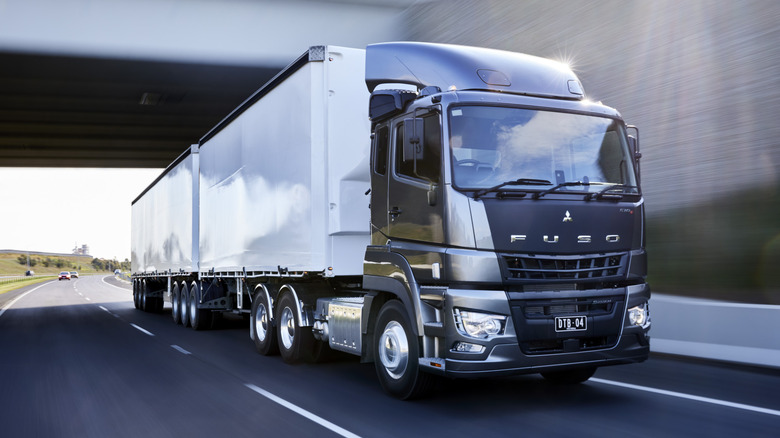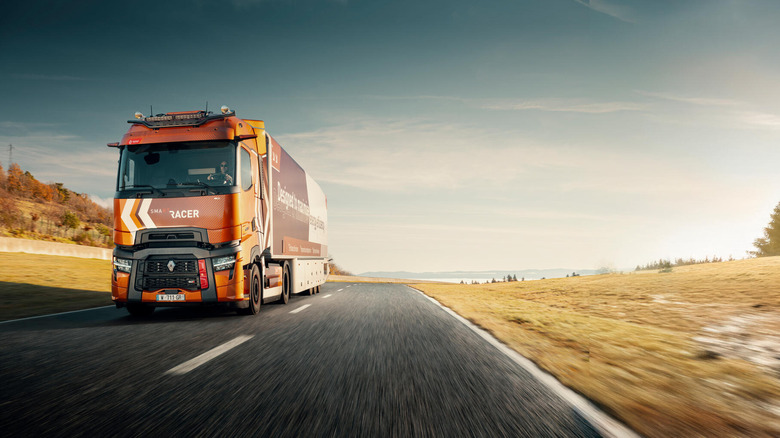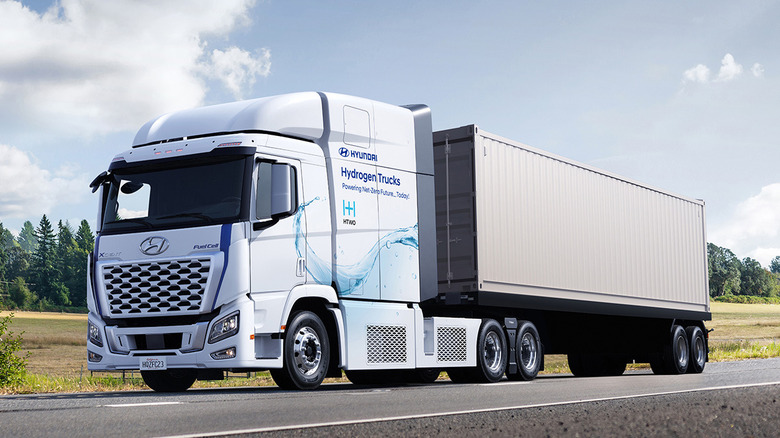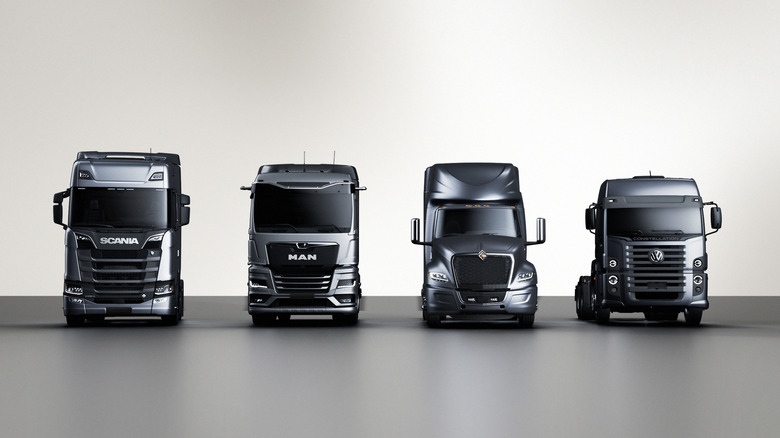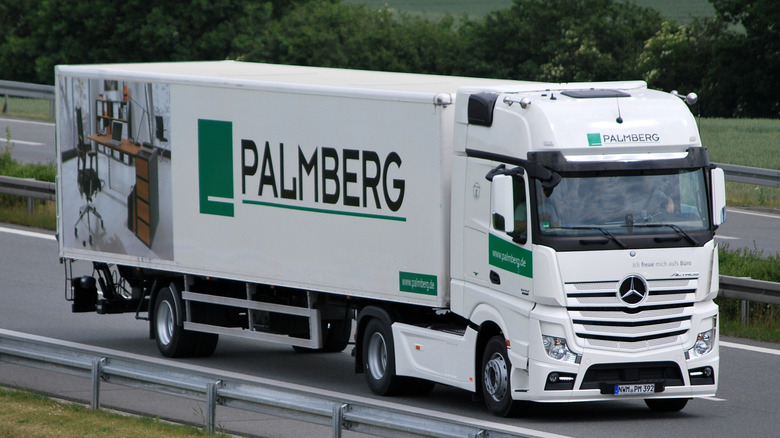8 Car Brands That Make Semi Trucks
Building trucks is tough. Some of the biggest carmakers in the world tried their hand at building semi-trucks and then withdrew from the market. Dodge's Big Horn semi-truck failed. GMC and Chevrolet used to sell semi-trucks, but neither of these brands offers one today. Ford used to sell heavy-duty trucks in the United States, including its L-series, which was available as a semi-truck, but it sold that line of business to Freightliner in the late 1990s. It's worth noting that Ford still sells heavy-duty trucks overseas, using Ecotorq engines, sophisticated aerodynamics, and high-tech features for efficient transport.
The industry's competitive nature has led to many acquisitions and mergers. Of the seven truck brands that still build heavy-duty trucks in North America, Kenworth and Peterbilt belong to an Oregon-based parent company called PACCAR (which also owns the DAF brand overseas), Freightliner and Western Star are part of Daimler Trucks, International is owned by Volkswagen's Traton Group, and Mack is owned by Volvo Trucks North America, which also builds trucks here under its own brand. As we'll see below, the situation is similar overseas. It seems that allying with other truck builders offers advantages, including for passenger car manufacturers who build trucks.
Semi-trucks come with a vocabulary of their own. Semi-trucks in the USA are also known as semi-trailer trucks, tractor-trailer trucks, or simply semis. In the U.K. and Australia, the big rigs are referred to as articulated lorries. In continental Europe and elsewhere, they are often called tractor units. Plus, most semi-trucks are Class 8 trucks, although a few specialized trucks that pull super-heavy loads are Class 9. Cab sizes, engines, and other features vary based on the truck's intended use.
Volvo
Since GM discontinued the Saab car brand, Volvo is Sweden's sole surviving carmaker. It also makes semi-trucks for North American markets under the Volvo Trucks North America brand and for other markets under the Volvo Trucks brand. Both brands belong to the Volvo Group, which manufactures heavy-duty vehicles and engines for trucking, construction, and marine industries. Technically, Volvo Cars doesn't have a hand in building Volvo trucks, since the automobile brand is now owned by China's Zhejiang Geely Holding.
Volvo Trucks offers Class 8 semi-trucks, including redesigned diesel models and new electric models. In North America, it offers the VNL, VNR, and VNX semi-truck models, along with specialized semis like the VAH auto hauler and the VNR Electric model. It also offers non-semi-truck platforms, too. In Europe and elsewhere, it sells a wide range of straight trucks and semi-trucks, including forward-looking natural-gas-powered models and several electric models. In North America, non-electric models can be equipped with the cutting-edge D13TC engine, a direct-injection diesel inline six-cylinder with Volvo's Turbo Compound system, which generates up to 500 horsepower and 1,950 lb-ft of torque.
A reviewer from CleanTechnica drove Volvo Trucks North America's VNR Electric semi-truck and found it extraordinarily easy to drive, even for a driver with little experience driving semis, in a truck hauling a full load. This truck's four-battery system offers a 275-mile range, so it's a local delivery rig, but with 455 horsepower and 4,051 lb-ft of torque, it can definitely deliver. It's available in semi-truck and straight truck forms and 6x2 and 6x4 configurations.
Isuzu
Isuzu stopped selling in the United States as of January 2009, but it continues to sell pickup trucks and SUVs in other markets. Isuzu also doesn't sell semi-trucks in the U.S. Instead, it sells only straight truck cab-and-chassis platforms. However, in its home market of Japan and elsewhere in the world, it sells semi-trucks (which it refers to as tractor models) such as the EXR and EXZ. These are part of its new C & E series, which promises improved aerodynamics, advanced driving dynamics, a more comfortable and ergonomic cab, and hand grips and side steps to offer access to the whole exterior of the cab for maintenance or cleaning.
Isuzu trucks are all cab-over designs, which means the cab sits above the engine. This design is typical in most of the world outside of North America. By comparison, trucks in North America usually have the engine in front of the driver's cab, giving the tractors of American trucks their distinctive long-nosed appearance. These rigs also tend to have attached living space, an arrangement called a sleeper cab, since the long distances on North American roads mean that drivers often sleep in their trucks overnight. Plus, American roads offer room for longer cabs, which can be 20 feet long compared to the cabs of tractor units in Europe and elsewhere, which are closer to ten feet long. These are among several reasons why European and Asian trucks look different than those in America.
Isuzu's 6WG1-TC direct-injection diesel engines generate 309 kW (420PS) of power, which is approximately 414 horsepower. They also produce 1,863 N-m of torque, which is about 1,375 foot-pounds. Anti-lock brakes, LED headlights, and an optional automated manual transmission (AMT) are among the modern technologies on offer.
Tesla
Tesla Motors' products draw outsized attention, and the Tesla Semi is no exception. Commercial trucks make a good use case for electrification, since the instant-on torque of electric motors comes in handy when a vehicle is pulling a heavy load. To that end, the Tesla Semi uses the powertrain from the Tesla Model S sedan, which is a tri-motor arrangement that produces 1,020 horsepower and 1,050 lb-ft of torque in the sedan. Tesla isn't hugely forthcoming about whether the tri-motor setup produces the same power and torque figures in the Semi, but we do know that the front engine from the Model S is fitted to the Semi's rear axle, and the twin rear motors from the sedan drive the middle axle.
The Semi needs to move lots of mass for long distances without stopping to recharge, so the battery pack in the Semi is a 1,000-kWh unit versus the 100-kWh battery in the Model S. In late 2022, Tesla demonstrated the Semi's ability to cover 500 miles on a single charge of this massive battery pack with the first truck it delivered to a customer. This customer was PepsiCo, which ordered 100 Semis and used the first one to deliver snacks to an event celebrating the first truck's entry into service.
By late 2024, Tesla Semis had covered a combined 5 million miles and shown that this electric truck can cover up to 1,000 miles in a day with pit stops for fast recharging. The Semi is reported to be capable of being fitted with a sleeper cab for long-distance hauling, and can theoretically meet European regulations should it be exported someday.
Mitsubishi Fuso
In markets outside the U.S., Mitsubishi Fuso sells the FZ series and TV series of tractor trucks. In Australia, they offer the Shogun 510 6x4. The company's full name is Mitsubishi Fuso Truck and Bus Corporation, and its parentage and current ownership demonstrate the interconnectedness of the international truck manufacturing industry and the advantages of merging companies' resources. Mitsubishi Fuso is majority-owned by Daimler Truck AG, which spun off from Mercedes-Benz. Daimler Truck itself owns numerous truck brands around the world. Mitsubishi Motors, the carmaker, still owns a small stake in Mitsubishi Fuso. Looking at who owns Mitsubishi Motors, Nissan owns a controlling interest in Mitsubishi as part of the Renault-Nissan-Mitsubishi Alliance.
Confused yet? Welcome to the globalized truck-building industry. This interconnected matrix of manufacturers results in some excellent heavy-duty trucks, though. In Mitsubishi Fuso's case, the FZ Series offers a chassis with an extra-durable frame and full-depth long members to support heavy loads. Differential locks between wheels and between axles serve as a type of limited-slip system. The FZ Series is ideal for countries where the roads may be rough to non-existent in spots.
The TV Series is also designed for demanding conditions. It features a high-volume air cleaner, twin 400 mm clutch discs for durability, and high-mounted air brake chambers for rough terrain clearance. Optimized shaft distance offers better maneuverability. The chassis has been shot-blasted and powder-coated to prevent rust. Its power-shift transmission makes life easier for the driver. A typical engine can be found in the TV Series Thunderbolt 6x4, which offers a 12-liter, water-cooled, direct-injection, turbocharged diesel with ECU-controlled fuel injection for greater fuel efficiency.
Renault
The French automaker Renault also builds a line of commercial trucks that includes the T, C, and K lines of semi trucks. The Renault Trucks division is a major player in the international heavy goods vehicle market, with 70,000 units sold in 2023. In addition to traditional diesel-powered trucks, Renault is moving into eco-friendly technologies such as compressed natural gas, biofuels, and electric motors. Renault builds its trucks in France, although some can be shipped disassembled to partners in Africa and the Middle East for local assembly.
Renault Trucks T and Trucks T High are part of its long-haul range, while the C range and the K range are construction-oriented but with available tractor-unit semi-truck models. For 2025, all three ranges offer improvements in energy efficiency, safety features, and comfort. Fuel efficiency improves by up to 3% via powertrain optimizations and aerodynamic enhancements. Other innovations include replacing traditional mirrors with camera systems on some models, which even provide infrared capability for night visibility. The T range can be ordered in the Smart Racer configuration, which uses a DE13 Turbo Compound engine and other innovations to deliver a 14% fuel reduction and lower CO2 emissions.
Engines include a range of diesels, while the E-tech T electric truck offers 375 miles of range on one charge. Safety improvements across all of Renault Truck's ranges include an advanced adjustable power steering system for greater stability on the highway while still offering maneuverability in urban environments. Additional safety features include a lane-keeping system that also offers protection against objects and vehicles in the truck's blind spots. Automatic high beams respond to darkness, weather, and other vehicles on the road.
Hyundai
Hyundai Truck & Bus belongs to the Hyundai Motor Company, which owns car brands including Hyundai, Kia, and Genesis. This makes the relationship between Hyundai, the carmaker, and Hyundai, the truck maker, more straightforward than other companies. There are no spin-offs or brands partially or completely owned by other companies, as we've seen elsewhere on this list. As a truck manufacturer, Hyundai's history dates back to 1969 when the company began building trucks and buses. Its semi-trucks have included the Trago line, which debuted in 2006. Hyundai Truck & Bus has also built numerous buses, flatbeds, construction vehicles, and vans.
Recently, Hyundai's XCIENT line of semi trucks has made waves with its new hydrogen fuel cell variant, which entered fleet duty in the U.S. in the summer of 2023. While some of hydrogen's thunder has been stolen by electric vehicles like the Tesla Semi in recent years, Hyundai still believes hydrogen offers advantages for heavy-duty trucking. For one thing, it's far quieter than diesel, making for a more pleasant experience for truckers and bystanders alike. This is especially true in circumstances where trucks must idle for long periods. Hydrogen power also offers good acceleration at all speeds, like electric vehicles.
More recently, Hyundai demonstrated an autonomous version of the XCIENT at the 2024 Advanced Clean Transportation Expo. The truck uses Hyundai's Plus SuperDrive to achieve Level 4 autonomous driving. This level of self-driving allows a vehicle, in theory, to travel without a human driver within prescribed circumstances that are up to the manufacturer. (By comparison, Level 5 allows a vehicle to go anywhere, anytime, in any circumstances without a driver, though whether that will ever be achieved is debatable). For now, Hyundai aims to augment drivers' safety and fleet efficiency with the system, rather than replacing drivers altogether.
Volkswagen
Volkswagen owns the Traton Group of commercial vehicle manufacturers, which includes four brands: Scania, MAN, VW Truck & Bus, and International. All four companies manufacture semi trucks. The Traton Group's headquarters are in Munich, Germany, and Södertälje, Sweden. Volkswagen Truck & Bus focuses on emerging markets in Africa, Latin America, and Asia. It recently debuted the VW Meteor Hybrid concept truck for the Brazilian market. Sweden's Scania, meanwhile, offers a full line of trucks, including a range of semi-trucks powered by the Scania Super. This is an ultra-efficient 13-liter turbocharged diesel engine producing up to 560 horsepower and 2,065 lb-ft of torque.
MAN Truck & Bus, headquartered in Germany, builds trucks and buses with a strong focus on zero-emission technologies such as hydrogen fuel cells, as well as low-emission diesels. Its semi-truck offerings include the TGX and TGS series, each of which focuses on fuel efficiency and ergonomics. And finally, the Traton Group owns the U.S.A.'s International, which was founded in 1831 as an agricultural company and joined the Traton Group in 2021. Its heavy-duty big rigs include the long-haul LT and local and regional RH Series, both with the highly efficient S13 Integrated Powertrain. International trucks are made in five plants around the United States and Mexico.
The Traton Group recently teamed up with a software company called Applied Intuition to create vehicle software platforms. This would essentially be an operating system for the trucks, with the bonus of offering advanced driver assistance features. Artificial intelligence will be deployed to develop and power the software.
Mercedes-Benz
Mercedes-Benz Trucks manufactures a line of long-distance semi-trucks called Actros and construction semis called Arocs. Both lines offer a range of models for tasks up to and including towing 500 tons. The Actros L ProCabin balances aerodynamics and a comfortable cabin with a bunk. For those who don't need a sleeper cab, there's the base Actros L. The Actros F is a more stripped-down, cost-efficient version of the Actros line. The Actros L for heavy-duty transport can pull 180, 250, or 500 metric tons of gross combination weight.
The semi-truck version of the Arocs line features extra robustness for handling the tough environment of construction sites. It offers high ground clearance and a big angle of approach, along with protective bodywork like steel bumper corners. The Hydraulic Auxiliary Drive provides more traction on treacherous surfaces. A turbo retarder clutch makes it safer to pull extreme loads up or down steep hills. The Arocs 500 t brings the extreme capability of towing up to 500 tons.
Commercial Motor Magazine reviewed an Actros 2545LS 6x2 and concluded that it was "probably the most technologically advanced truck ever to have undertaken our intensive two-day Scottish challenge." It noted the ultra-fuel-efficient transmission software, the fifth-generation Mercedes Active Brake Assist, and the all-digital, Multimedia Cockpit dashboard. The mirror cameras were criticized for misting up on rainy days. On the other hand, the sleeper cabin abounds with thoughtful touches like a charging pad for cell phones, good storage, and multiple charging points. Ride and handling were excellent, while driver assist tech worked well as long as the driver didn't become over-reliant on it.
